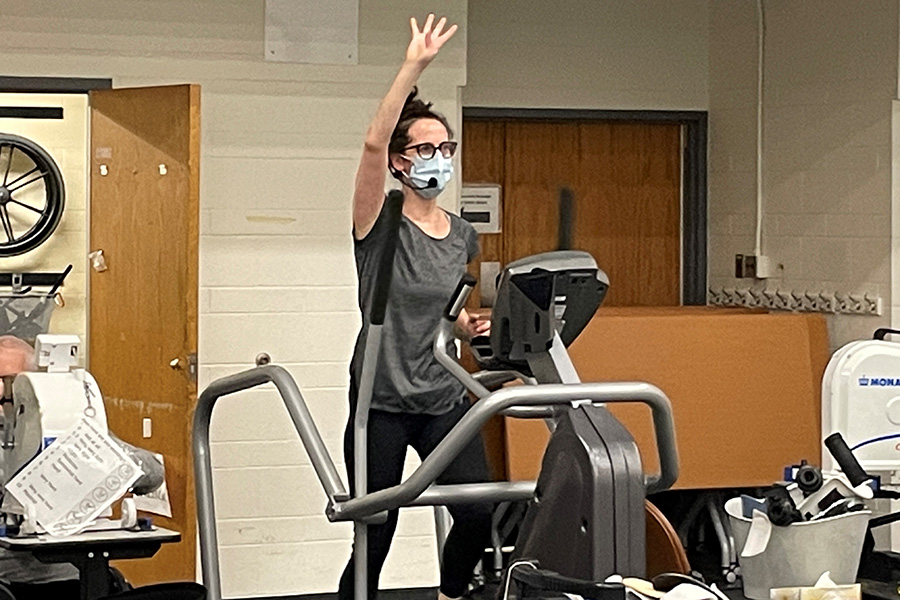Dragan Cvetanovic, far right, rides in a high-intensity group fitness class at Toronto Rehab’s Lyndhurst Centre. He says he’s not sure he would be as far along in his rehabilitation without this class. (Photo: UHN)
It’s no secret that group fitness classes can help keep participants motivated and accountable.
But at Toronto Rehab’s Lyndhurst Centre, where staff are dedicated to helping people with spinal cord injuries regain as much functional independence as possible, the benefits reach even further: helping patients maximize physical improvements and have an opportunity to make progress beyond regularly scheduled therapy sessions.
“Inpatients are with us for such a short period of time, so our goal is to ensure they’re making every minute count,” says physiotherapist Gillian Johnston, who launched an elective group fitness class, called Lyndhurst Interval Training (LIT), earlier this year.
The purpose of LIT is to use gaps between scheduled therapy more effectively, and keep patients focused on their rehab goals.
“LIT offers patients an opportunity, in addition to therapy, to exercise in a safe, motivating, and high-intensity environment,” Gillian says. “And patients are telling us they can feel the difference it’s making.”
‘I’m not sure I’d be as far along in my rehab, if I was working out on my own’
One of those patients is Dragan Cvetanovic. The accident he incurred while on a wilderness trip left him unable to walk or effectively use his upper extremities.
His rehab goals are to get back to fishing, which he calls his life, and to navigate stairs when he goes back home.
To that end, Dragan practices walking during therapy sessions, and joins the 3:15 p.m. LIT classes to help increase his endurance.
“My rehab day is done now, but I want to keep going,” says the 54-year-old, adding he’d otherwise be spending his time outside, relaxing, or in his room, tidying up, or going over new therapies from the day.
“I like attending the LIT class, because I know I’m getting a good workout,” says Dragan, who likes to ride an adapted elliptical machine for each class.
“My endurance is up, I can stand up longer, and I can walk further. I’m not sure I’d be as far along in my rehab, if I was using down-time to work out on my own.”
Such sentiment is what motivated Gillian to launch LIT in Lyndhurst’s large, fully equipped gym.
“Along with one-on-one therapy, each patient is prescribed an independent exercise program to follow in their own time,” she explains.
“But we know it can sometimes be hard to motivate yourself to work out alone, as well as reach a high-enough intensity to achieve therapeutic benefits.”
LIT checks both of these boxes.
‘Using this approach, we may be able to get more done in a shorter time’
Inspired by the high intensity interval training (HIIT) trend, which combines short bursts of intense exercise with periods of rest, LIT runs for just 20 minutes, twice a week, toward the end of the day.
“Research in the SCI population has shown that benefits of HIIT are the same, if not better, than the benefits gained from the same type of activity done at a lower intensity over a longer period of time,” says Gillian.
“Using this approach, we may be able to get more done in a shorter time – which is especially important for inpatients who have a limited number of hours in their day to fit in as much rehab as possible.”

As participants file into the gym, stop to chat with one another, and choose the equipment they’ll stay on for the duration of the class, staff are on hand to help them safely set up and strap in.
Gillian sets up her own bike or step in the middle of the room, so she can be seen by everyone and exercises along with the group.
With participants’ ages ranging from 19 to 85, and levels of mobility varied, the class promotes inclusivity by using a Rating of Perceived Exertion – an individualized measure, using a scale from 1-10, that all participants are already familiar with.
“I’ll say, ‘I want you to be at a four on 10 right now, and then we’ll go for 20 seconds at a seven on 10.’ That speed and resistance will look different for everyone,” explains Gillian.
She also looks for different ways to motivate them, from inviting participants to bring music play lists for each class, to incorporating visualization.
“I might say, ‘what’s your goal for this week? Are you going to sit up on your own? Walk an extra few metres? Pull on your own shirt? Have that goal in your head, and during each sprint, visualize it!'”
“It’s short and sweet, and I yell at them, just like a real fitness instructor would,” she jokes.
The future of LIT – extending beyond hospital walls
Early surveys show that the class is being well received among participants. They cite benefits such as camaraderie, the ability to push themselves, and the rush of adrenaline that’s felt after a good workout, and overall satisfaction ranges between seven to 10 out of 10.
Gillian hopes that LIT can play a future role in strengthening Toronto Rehab’s connection to the community, and encouraging patients to continue being active, once they’ve safely transitioned back to their community.
“It’s not just about how we manage patients here, but what we, as healthcare leaders, are inspiring them to do, post discharge,” she says.
To that end, she’d love to see the program live-streamed into people’s living rooms, where, if they don’t have machines, can simply follow along with their own exercise program, and eventually led by peer supporters.
“We want to show patients that exercise is essential to making gains when they’re here at Lyndhurst, but that it also needs to become part of their lifestyle, once they’re home,” Gillian says.


